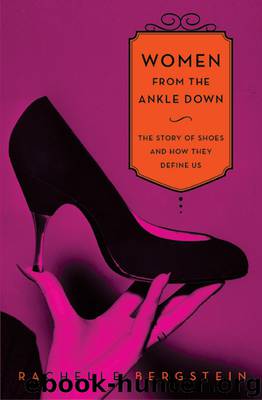Women From the Ankle Down by Rachelle Bergstein

Author:Rachelle Bergstein
Language: eng
Format: epub
Publisher: HarperCollins
12
Manolo, Molloy, and the New Power Shoes
(1975–1982)
Cone-heeled pumps
Before Manolo Blahnik was a household name, he was an imaginative boy who grew up in the Canary Islands, in between the crystal blue ocean and the banana plantations, with a chic mother who inspired his nascent love of art. In the early 1970s after studying literature and architecture in Geneva, he put on his best red-and-white gingham suit and approached American Vogue editor Diana Vreeland with his designs; a letter of introduction from Paloma Picasso got the young hopeful through the door. Among sketches for the set of a production of A Midsummer Night’s Dream, Manolo included playful drawings of fashion accessories. Vreeland, a sleek woman with jet-black hair and exaggerated Gallic features, appraised his work and then offered her verdict:
“I think you should concentrate on shoes,” the legendary tastemaker told him.
Blahnik listened and found a job designing footwear for a London boutique, and by 1972 he landed his first major commission to create the runway shoes for English designer Ossie Clark’s spring-summer collection. Manolo got right to work, drawing seasonally inspired two-tone green high-heeled sandals with ankle ties that crisscrossed up the calf and dripped with red plastic cherries, and electric blue open-toed pumps with red straps and seven-inch rubber heels. The young shoemaker knew what he liked and couldn’t wait to see his creations come to life; he found the chunky platform awkward and oppressive and sought to promote shoes that made a woman’s foot look delicate instead of heavy. Unfortunately, that quest for lightness proved to be his downfall; on the catwalk, his springy heels buckled and Clark’s models couldn’t make it to the end. Such a disaster might have felled a lesser designer, but Blahnik understood that his technical expertise did not yet live up to his creative abilities, so he left London for Northampton—the center of English shoemaking—to study craftsmanship. It wasn’t long before he rebounded from the Ossie Clark debacle. The handsome Manolo appeared on the cover of British Vogue in 1974, opened a boutique in the States in 1979, and designed the delicate gold sandals Bianca Jagger wore when she rode a white horse into Studio 54 on her thirtieth birthday.
Blahnik’s shoes appealed to a particular demographic of wealthy, elegant women willing to pay top dollar for quality pieces. He made his name designing classic pumps and sandals, prioritizing his own taste for sexy, elegant shoes over any passing trends. And as the platform flourished in the nightlife scene, the traditional pump—classic and dignified—made a resurgence during daylight hours. Once again, women’s needs changed; for a long time, women had been an important part of the workforce, but only as the low-profile nurses and secretaries to the doctors and CEOs they supported. From 1972 to 1985, the number of women in professional roles increased by 5 percent, but their presence in managerial jobs nearly doubled, from 20 percent to 36 percent; the proverbial glass ceiling started to crack, and women’s careers no longer had to culminate—by default—shy of the corner office.
Download
This site does not store any files on its server. We only index and link to content provided by other sites. Please contact the content providers to delete copyright contents if any and email us, we'll remove relevant links or contents immediately.
| Advertising | Annuals |
| Book Design | Branding & Logo Design |
| Fashion Design | Illustration |
| Science Illustration |
Wonder by R.J. Palacio(8462)
Mastering Adobe Animate 2023 - Third Edition by Joseph Labrecque(3764)
Unlabel: Selling You Without Selling Out by Marc Ecko(3587)
Ogilvy on Advertising by David Ogilvy(3506)
Hidden Persuasion: 33 psychological influence techniques in advertising by Marc Andrews & Matthijs van Leeuwen & Rick van Baaren(3472)
Drawing Cutting Edge Anatomy by Christopher Hart(3453)
The Pixar Touch by David A. Price(3362)
POP by Steven Heller(3307)
The Code Book by Simon Singh(3074)
The Art of War Visualized by Jessica Hagy(2943)
Slugfest by Reed Tucker(2938)
The Curated Closet by Anuschka Rees(2912)
Rapid Viz: A New Method for the Rapid Visualization of Ideas by Kurt Hanks & Larry Belliston(2833)
Stacked Decks by The Rotenberg Collection(2811)
365 Days of Wonder by R.J. Palacio(2751)
The Wardrobe Wakeup by Lois Joy Johnson(2732)
Keep Going by Austin Kleon(2696)
Tattoo Art by Doralba Picerno(2600)
Tell Me More by Kelly Corrigan(2591)
